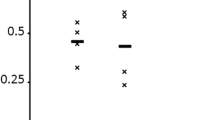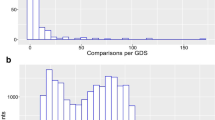Abstract
The identification of disease-causing genes is the first and most important step toward understanding the biological mechanisms underlying a disease. Microarray analysis is one such powerful method that is widely used to identify genes that are expressed differently in two or more conditions (disease vs. normal). Because of its large library of statistical R packages and user-friendly interface, the R programming language provides a platform for microarray analysis. In this chapter, we will go over how to identify disease-causing culprit genes from the raw microarray data, using various packages of R programming. The pipeline overviews the steps in microarray analysis, such as data pre-processing, normalization, and statistical analysis using visualization techniques such as heatmaps, box plots, and so on. To better understand the function of the altered genes, gene ontology and pathway analysis are performed.
Access this chapter
Tax calculation will be finalised at checkout
Purchases are for personal use only
Similar content being viewed by others
References
Mohammadi A, Saraee MH, Salehi M (2011) Identification of disease-causing genes using microarray data mining and gene ontology. BMC Med Genet 4(1):1–9
Ma C, Ji T (2018) Detecting differentially expressed genes for syndromes by considering change in mean and dispersion simultaneously. BMC Bioinform 19(1):330
Selvaraj S, Natarajan J (2011) Microarray data analysis and mining tools. Bioinformation 6(3):95–99
Lee MLT (2007) Analysis of microarray gene expression data. Springer Science & Business Media, Springer New York Inc.
Almugren N, Alshamlan H (2019) A survey on hybrid feature selection methods in microarray gene expression data for cancer classification. IEEE Access 7:78533–78548
Gautier L, Cope L, Bolstad BM, Irizarry RA (2004) affy—analysis of Affymetrix GeneChip data at the probe level. Bioinformatics 20(3):307–315
MacDonald JW (2019) Affycoretools: functions useful for those doing repetitive analyses with Affymetrix GeneChips. (2018). R package version 1(1)
Kauffmann A, Gentleman R, Huber W (2009) arrayQualityMetrics—a bioconductor package for quality assessment of microarray data. Bioinformatics 25(3):415–416
Ritchie ME, Phipson B, Wu DI, Hu Y, Law CW, Shi W, Smyth GK (2015) Limma powers differential expression analyses for RNA-sequencing and microarray studies. Nucleic Acids Res 43(7):e47
org.Hs.eg.db. In: Bioconductor. http://bioconductor.org/packages/org.Hs.eg.db/
hgu133a.db. In: Bioconductor. http://bioconductor.org/packages/hgu133a.db/
Wu T, Hu E, Xu S, Chen M, Guo P, Dai Z, Feng T, Zhou L, Tang W, Zhan L, Fu X (2021) clusterProfiler 4.0: a universal enrichment tool for interpreting omics data. The Innovation 2(3):100141
Yu G, Wang LG, Han Y, He QY (2012) clusterProfiler: an R package for comparing biological themes among gene clusters. Omics J Integr Biol 16(5):284–287
Sui Y, Zhao X, Speed TP, Wu Z (2009) Background adjustment for DNA microarrays using a database of microarray experiments. J Comput Biol 16(11):1501–1515
Fundel K, Haag J, Gebhard PM, Zimmer R, Aigner T (2008) Normalization strategies for mRNA expression data in cartilage research. Osteoarthr Cartil 16(8):947–955
Acknowledgments
CM gratefully acknowledges MAKAUT, WB for providing computational facilities and Sweta Paul, student of M.Sc. Bioinformatics for building partial R data analysis pipeline.
Author information
Authors and Affiliations
Editor information
Editors and Affiliations
Rights and permissions
Copyright information
© 2024 The Author(s), under exclusive license to Springer Science+Business Media, LLC, part of Springer Nature
About this protocol
Cite this protocol
Banerjee, A.K., Ghosh, S., Mal, C. (2024). Identification of Culprit Genes for Different Diseases by Analyzing Microarray Data. In: Mandal, S. (eds) Reverse Engineering of Regulatory Networks. Methods in Molecular Biology, vol 2719. Humana, New York, NY. https://doi.org/10.1007/978-1-0716-3461-5_10
Download citation
DOI: https://doi.org/10.1007/978-1-0716-3461-5_10
Published:
Publisher Name: Humana, New York, NY
Print ISBN: 978-1-0716-3460-8
Online ISBN: 978-1-0716-3461-5
eBook Packages: Springer Protocols




